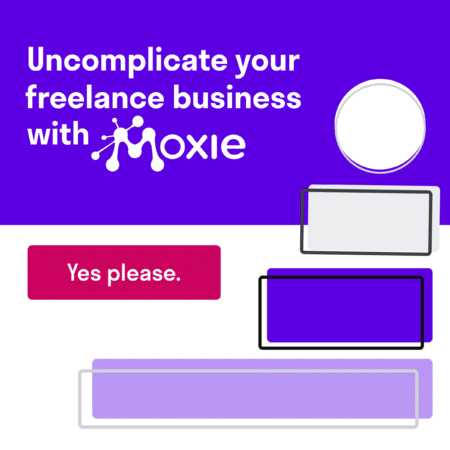Knowing what to do when a client doesn’t pay can be a real challenge.
When you work for a client, you give them your time, your expertise, and your own personal touch. You give them a piece of yourself. So when a client doesn’t pay you for your work, it feels personal.
In this article, you’ll learn what to do when a client doesn’t pay and how to prevent it from happening again.
It hurts when a client doesn’t pay
Non-payment comes in many forms, and every one of them hurts.
Your client may claim they can’t afford to pay you even though that never seemed to be a possibility when they hired you.
If you’re a subcontractor, they may tell you they’re waiting for their client to pay them first.
They may insult the quality of your work.
They may try to wiggle out of paying, citing the lack of a formal contract or some other technicality.
Or they may stop returning your calls and disappear when the bill comes due.
Getting paid depends on you being proactive
How you proceed depends on you. You earned your money, and you deserve to get paid in full.
If you’re up for the challenge, there are steps you can take before giving a chunk of what you earned away to collection professionals.
On the other hand, you may decide your time and energy are too valuable to spend chasing down payment. There are good arguments to be made both for walking away from a bad client and also for skipping some of the do-it-yourself steps below and going straight to a collection agency or lawyer.

Every situation is different, and you’ll need to tailor your approach depending on your situation. There are, however, common themes in most situations.
11 Steps to take when your client doesn’t pay

1. Get in the right mindset about money.
Before you spring into action, it’s important to check in with yourself. Remind yourself that your client’s failure to pay you isn’t your fault.
Realize that nonpayment happens to most freelancers and small business owners at least once in their careers, so you’re not alone.
You need to emotionally detach as much as possible because the best moves you can make often aren’t the ones your heart will dictate.
This is a time to be “all business” and prioritize payment above the satisfaction of lashing out at your client.
It’s time to overcome the fear of awkward money conversations with clients (like we coached Bri in this landmark episode of Freelance to Founder.)

2. Set up yourself for success from the start.
Facing issues with clients that don’t pay is a sign that you don’t have a true collection system in place or that you are ignoring some client red flags from the beginning.
Setting up an invoicing tool like Hectic as your collection system is a good way to set up your new client relationship for success from the start.
Clients that are serious and worth your time will rarely go against setting up recurring payments or using a card to pay you. It’s all about mutual trust in the meantime.
Hectic’s automatic recurring invoices features, follow-ups, late fee options, and more are a good way to simplify your process, make it professional, and safe for both parties since the beginning.
3. Make it clear to your client that it’s time to pay.
Up to this point, you may have had a more casual relationship with your client around payment because it hasn’t been an issue.
If you haven’t held them to payment deadlines before, now is the time to reset expectations. Always be polite and let them know there’s nothing personal, but make it clear that this is your livelihood and you’re a professional, so you expect to be paid promptly, just as they would pay any larger company.
Let them know you won’t continue to work for them if they have past-due invoices with payment and you don’t want to have to “take more serious steps”.
It’s okay at this stage to be vague about the more serious steps you’d take because you’re trying to keep everything civil.

4. Stop working for free!
If you’re still working for this client and no money has shown up in your account, pause your work and let them know you have no choice but to freeze their account until things are made right.
Don’t give in if they try to guilt-trip you into continuing work.
Of course, your work is important to their business, but they need to realize their payment is important to you being able to pay your bills.
5. Be bold.
You’ve had the talk and your client committed to settling their bill, but their actions aren’t consistent with their promises and you still haven’t been paid.
Now is not the time to be meek.
Pick up the phone or visit your client in person. Confrontation isn’t fun for either of you, but it’s often effective.
6. Be persistent.
Continue contacting your client so they realize the problem isn’t going to go away if they ignore it.
You should contact them around twice a week ‒ once by email and once by phone.
While calls are effective, it’s important to have a record of your attempts and your client’s failure to pay, so emails are an important part of the mix.
You can also use invoicing software with automatic reminders to add to the number of times your clients are being reminded each week.
One tool that we recommend for this task is Bonsai.
With Bonsai, automatically create your next invoice, remind your client for payment, accrue an overdue late fee, and send you read-receipts.
7. Bring others into the mix to exert pressure.
At this point, it’s fair game to reach out to your client’s boss, investors, partners, client (if you’re a subcontractor), employees, etc.
Make sure you stick to the facts, but tell these involved parties that you’re having trouble getting paid and ask if there’s anything they can do to help.
Embarrassment can be a powerful tool.
8. Send your client a formal Demand Letter.
Taking an additional step to formalize and document your grievance is a necessary step if you wind up deciding you want to sue your client.
Even if you don’t ever intend to sue, however, the threat may be enough to move them to act.
You can find a sample Demand Letter below.
9. Decide whether you want to go further.
At this point, it’s clear that your client isn’t going to pay without some outside influence.
It may not be worth the stress and anxiety to pursue further, especially if you’re dealing with a relatively small amount.
There could also be other considerations to take into account. For example, your client may be able to blacklist you in your industry, or you might have to see them again and again socially.
So as painful as it may be, your best decision might be to walk away. If that’s not the case, it’s time to escalate the situation.
10. Take them to Small Claims Court.
There are pros and cons to Small Claims Court.
The positives: You’ll keep 100% of the money recovered, and it’s relatively inexpensive (typically less than $100) to file the suit.
The negatives: You’ll have to spend more of your time going to court. If you win, you’ll get a piece of paper that says your client owes you money, but if they don’t comply, you’ll have to embark on an additional journey to collect.
Small Claims isn’t an option if you’re not in the same area as your client, because you likely will have to sue in their home venue. The limit for Small Claims Court varies by state, but most states’ caps fall between $5,000 and $10,000.
11. Hire a lawyer or collection agency.
Bringing in a professional should be your last resort because it’s expensive, but if you’ve moved through the steps listed above or if you don’t want to spend the time and energy to go through them, it’s likely time to get an experienced attorney to handle your overdue account.
Collection Agencies
Hiring a collection agency is often a good first step before hiring a lawyer.
Collection agencies keep a piece of what they collect, but they don’t charge anything upfront. They’ll get your client on the phone and attempt to negotiate a resolution before moving the account along to legal collections.
There is a wide range in quality among collection agencies. Some will make one call to your client and give up the second there’s any resistance, so do your research before hiring one.
Lawyers
Lawyers are very effective, but even if you hire one who works on contingency (as opposed to billing by the hour), you’ll have to pay for court filing and service of process, which means you’ll have to spend hundreds of dollars without any guarantee of success.
If you’re owed a large amount or if you’re sure your client is the type of person to say, “You won’t get a dime without suing me,” it makes sense to skip the collection agency option and go straight to a lawyer, but don’t rely on just any lawyer.
Commercial collections is a specialized field, and you want an advocate who knows how to avoid the pitfalls and get a good result.
Sample letter for demanding payment from your client
Here’s a sample Demand Letter for when a client doesn’t pay. When you send your client a letter like this, make sure to send it via Certified Mail with the return receipt requested. You’ll want the return receipt to prove your client received the letter if you ever take them to Small Claims Court.
Dear [CLIENT],
You entered into a service agreement with me on [DATE]. In accordance with that agreement, I have performed services and you are required to pay for the services I have provided. Per the terms of our agreement, you are required to make payment of [$X] within [XX] days of receiving an invoice.
It has been [XX] days since my last invoice was sent, so payment of [$X] for services rendered is now [XX] days late and you are now in breach of contract.
Please pay [$X] no later than [DATE]. If you fail to respond, I will be compelled to pursue legal action.
Please find attached copies of our contract, email correspondence, and other documents confirming the delivery of my services and outlining your obligations under the terms of our contract.
Thank you in advance for your prompt attention to this matter. I look forward to hearing from you and to a swift resolution.
Regards,
[YOUR NAME]
[ATTACH YOUR CONTRACT, INVOICES, EMAILS, TEXTS & OTHER RELEVANT DOCUMENTS]
SOURCE: TheFreelanceFiles.com
What NOT to do when your client hasn’t paid
When you find out your client doesn’t intend to pay you, it’s natural to be angry, but you need to resist the urge to lash out. Here are a few things to avoid when you confront nonpayment:
- Don’t trash talk your client to their face, behind their back in the business community, on social media, or anywhere else.
- Don’t threaten your client or do anything else that might get you sued.
- Don’t be lazy and let an overdue invoice collect dust. They become harder to collect over time.
- Don’t throw good money after bad by spending on a lawsuit unless a reputable commercial collections lawyer thinks you have a very good (80%+) chance at a successful outcome.
- Don’t spend more of your valuable time or emotional energy than you have to.
- Don’t hesitate to end a relationship with a client who doesn’t pay.
Knowing when to cut your losses with a client who doesn’t pay
If you get to the point where your own efforts aren’t bearing fruit and you don’t want to go to Small Claims Court or bring collections professionals into the equation, walking away can be a smart decision. It’s important to balance your efforts to get paid with your time and emotional well-being.
You also may hit a wall even after bringing professionals into the equation. If your client is bankrupt and there’s no money to recover, or if the collection agents or lawyers determine that negotiations won’t work and it’s not worth the expense of suing in court, you may have to abandon your efforts and move on.
Checklist to ensure you get paid next time
Here are a few common-sense rules you should follow so you don’t wind up in a nonpayment situation in the future:
- Use a contract. Some of the Invoicing & Project Management resources on Millo’s tools page have templated contracts as part of their systems. Contracts drafted for you by a lawyer are the gold standard, but templated contracts are far better than none at all.
- Live by The Google Rule. Do some basic research on your client before accepting an engagement.
- Get paid upfront. 50% has become standard. Unless you’re dealing with a large company with a long track record, there’s something wrong if a client won’t pay anything upfront. This is especially important if you’re considering working for a startup or some other type of company that’s not sure to be around for a while.
- If a customer falls behind on payment, be proactive to make sure they resolve the situation quickly, before a minor issue turns into a major one. This can be done with most invoicing tools for freelancers which will notify your clients of unpaid invoices automatically. Our current favorite is Freshbooks.
- Trust your instincts when it comes to people. If someone won’t give you a straight answer to simple questions, that’s a red flag.
A common problem
You’re not alone. Over 70% of freelancers have encountered nonpayment in some form. You won’t always find a happy ending, but if it happens to you, you owe it to yourself to take smart steps to get paid and to minimize your exposure in the future.
Keep the conversation going...
Over 10,000 of us are having daily conversations over in our free Facebook group and we'd love to see you there. Join us!

